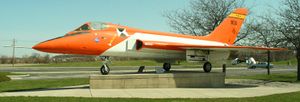PlaneSpottingWorld welcomes all new members! Please gives your ideas at the Terminal.
F5D Skylancer
| F5D Skylancer | |
|---|---|
| Douglas F5D Skylancer prototype in use by NASA for Dyna-Soar abort training | |
| Type | Fighter aircraft |
| Manufacturer | Douglas Aircraft Company |
| Primary users | United States Navy United States Marine Corp |
| Developed from | F4D Skyray |
The Douglas F5D Skylancer was a development of the F4D Skyray for the United States Navy. Starting out as the F4D-2N, an all-weather version of the Skyray, the design was soon modified to take full advantage of the extra thrust of the Pratt & Whitney J57 eventually fitted to the Skyray instead of the Westinghouse J40 originally planned.
Soon the design became too different to the Skyray to be considered just a variation of it, and the aircraft was assigned a new designation as the F5D Skylancer. Almost every part of the airframe was modified, though the basic form remained the same as did the wing shape, though it became much thinner. The wing skinning was reinforced, correcting a problem found in the F4D. The fuselage was 8 feet (2.4 m) longer and area ruled to reduce transonic drag, being thinner in the region of the wing roots. Everything was shaped to reduce drag and increase stability at high speed.
Although the four 20 mm cannon in the wing roots were retained, primary armament was to be missiles or rockets; four AIM-9 Sidewinders or two AIM-7 Sparrows, and/or a battery of spin-stabilized unguided 2 in (51 mm) rockets.
Nine test airframes were ordered, with a 51-aircraft production order to follow. Production aircraft were to be powered by the more powerful J57-P-14 engine, while there were plans to use the even more powerful General Electric J79.
The first flight was on April 21, 1956 and was supersonic; the aircraft proved itself easy to handle and perform excellently. However, after four aircraft had been constructed, the Navy cancelled its order. The stated reason was that the aircraft was too similar to the already-ordered F8U Crusader, but it is believed by some historians that politics played as big a part; Douglas was already building a very large proportion of the Navy's planes, and giving them the F5D contract would have made it even closer to monopoly.
The four aircraft continued to fly in various military test programs. Two were grounded in 1961, but the other two continued to fly; transferred to NACA (soon to become NASA) in the early 1960s, one was used as a testbed for the American supersonic transport program, fitted with an ogival wing platform (the type eventually used on Concorde; data from the program was shared with the European designers). This aircraft was retired in 1968. The other (pictured) was used for simulation of abort procedures for the X-20 DynaSoar, because it had a very similar shape and handling characteristics. Following the DynaSoar cancellation, it was used as a chase plane and for various other programs until it was retired in 1970. This last plane still exists at the Armstrong Air and Space Museum at Wapakoneta, Ohio, since Neil Armstrong flew the plane during the DynaSoar program.
Specifications (F5D)
General characteristics
- Crew: 1
- Length: 53 ft 9¾ in (16.40 m)
- Wingspan: 33 ft 6 in (10.21 m)
- Height: 14 ft 10 in (4.52 m)
- Wing area: 557 ft² (51.7 m²)
- Empty weight: 17,444 lb (7,912 kg)
- Loaded weight: 24,445 lb (11,088 kg)
- Max takeoff weight: 28,072 lb (12,733 kg)
- Powerplant: 1× Pratt & Whitney J57-P-8 turbojet
- Dry thrust: 10,200 lbf (45 kN)
- Thrust with afterburner: 16,000 lbf (71 kN)
Performance
- Maximum speed: 990 mph (860 knots, 1,590 km/h)
- Range: 1,335 mi (1,160 nm, 2,148 km)
- Service ceiling: 57,500 ft (17,500 m)
- Rate of climb: 20,730 ft/min (105.3 m/s)
- Wing loading: 43.9 lb/ft² (214 kg/m²)
- Thrust/weight: 0.65
Armament
- Guns: 4× 20 mm (0.787 in) cannon
- Rockets: 72× 2 in (51 mm) rockets
- Missiles:
- 4× AIM-9 Sidewinder or
- 2× AIM-7 Sparrow
Avionics
- X-24A radar
Related content
Related development
Comparable aircraft
Designation sequence
Related lists
See also
Naval Fighters: XFD · F3D · F4D · F5D · XF6D - Fighters: XP-48 · P-70 · F-6 · F-10
Naval Attack: DT · T2D · XT3D · BT · TBD · SBD · XBTD · XTB2D · AD · XA2D · A3D · A4D
Bomber: YB-7 · YB-11 · B-18 · XB-19 · XB-22 · B-23 · B-26 · XB-31 · XB-42 · XB-43 · B-66
Attack: XA-2 · A-20 · A-24 · A-26 · A-1 · A-3 · A-4
Reconnaissance: O-2 · OD · O2D · O-31 · O-35 · YO-44 · YOA-5 · PD · P2D · P3D
Transports: C-1 · C-21 · C-39 · C-47 · C-53 · C-54 · C-58 · UC-67 · C-74 · C-110 · C-118 · C-124 · C-133 · C-24
Naval Transports: RD · R2D · R3D · R4D · R5D · JD · R6D - Experimental: DWC · D-558-1 · D-558-2 · X-3
Lists relating to aviation | |
|---|---|
| General | Timeline of aviation · Aircraft · Aircraft manufacturers · Aircraft engines · Aircraft engine manufacturers · Airports · Airlines |
| Military | Air forces · Aircraft weapons · Missiles · Unmanned aerial vehicles (UAVs) · Experimental aircraft |
| Notable incidents and accidents | Military aviation · Airliners · General aviation · Famous aviation-related deaths |
| Records | Flight airspeed record · Flight distance record · Flight altitude record · Flight endurance record · Most produced aircraft |


